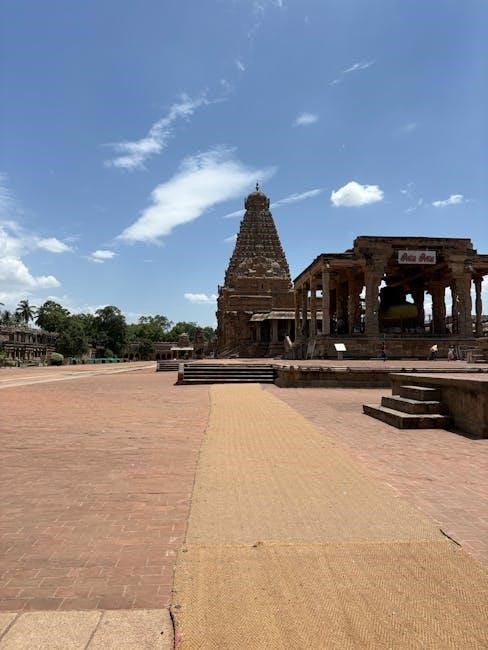The Lalitha Sahasranama is a revered Hindu devotional text featuring 1000 sacred names of Goddess Lalitha. It is a powerful tool for worship and spiritual growth, available in both Sanskrit and Tamil, enhancing its accessibility for devotees seeking divine connection.
1.1 What is Lalitha Sahasranama?
The Lalitha Sahasranama is a sacred Hindu text consisting of 1,000 divine names dedicated to Goddess Lalitha, a divine feminine deity. Each name embodies her divine attributes, spiritual significance, and cosmic roles. This hymn is deeply revered in Hindu spirituality, offering devotees a profound way to connect with the divine feminine energy. Its verses, often chanted or recited, are believed to bring spiritual enlightenment, inner peace, and fulfillment of desires. The text’s availability in Tamil enhances its accessibility for regional devotees.
1.2 Origin and Significance of Lalitha Sahasranama
The Lalitha Sahasranama originates from ancient Hindu scriptures, specifically the Brahmanda Purana. It is a hymn of profound spiritual significance, detailing the 1,000 names of Goddess Lalitha, symbolizing her divine attributes and cosmic roles. This text is deeply revered for its ability to bestow spiritual enlightenment and fulfill desires. Its significance is amplified by its availability in Tamil, making it accessible to a broader audience and enriching regional devotional practices. The hymn is often recited in temples and homes, fostering a deep connection with the divine feminine.
1.3 Importance of Lalitha Sahasranama in Hindu Devotion
The Lalitha Sahasranama holds a central place in Hindu devotion, offering a profound method for worshiping Goddess Lalitha. Its recitation is believed to grant spiritual enlightenment, peace, and fulfillment of desires. Available in Tamil, it bridges cultural and linguistic gaps, making it accessible to a wider audience. Devotees worldwide recite it in temples and homes, seeking blessings and fostering a deep spiritual connection. Its impact is further amplified by its availability in PDF format, ensuring its teachings reach modern seekers seamlessly.

Structure of Lalitha Sahasranama
The Lalitha Sahasranama is structured as a stotra, comprising 1000 divine names of Goddess Lalitha, organized into sections for easy recitation and meditation, blending Sanskrit and Tamil traditions seamlessly.
2.1 Overview of the 1000 Names
The Lalitha Sahasranama consists of 1000 names extolling Goddess Lalitha’s virtues, each name a mantra encapsulating her divine attributes. These names are divided into sections, each beginning with specific syllables like “Om Aim Hreem Sreem” to enhance their spiritual potency. The structure follows a rhythmic pattern, making it easier for devotees to recite and meditate. The PDF versions, especially in Tamil, preserve this sacred structure, ensuring that the essence and spiritual significance of each name are maintained for followers to connect deeply with the divine feminine energy.
2.2 Key Themes and Motifs in the Text
The Lalitha Sahasranama explores themes of divine femininity, cosmic creation, and spiritual liberation. It highlights Goddess Lalitha’s role as the universal mother, her cosmic dance, and her attributes of compassion and strength. The text also emphasizes her dual nature as both the creator and destroyer of ignorance. Recurrent motifs include her radiant beauty, divine grace, and the unity of existence. These themes are woven into the 1000 names, creating a tapestry of devotion and philosophical depth that guides seekers toward spiritual enlightenment and self-realization.
2;3 The Role of Sanskrit and Tamil in the Text
The Lalitha Sahasranama is rooted in Sanskrit, the sacred language of Hindu scriptures, ensuring its spiritual authenticity and traditional significance. Tamil translations, however, have made it accessible to a broader audience, especially in Tamil Nadu. The interplay between Sanskrit and Tamil preserves the text’s original essence while adapting it for regional devotion. Tamil versions often include transliterations and meanings, aiding devotees in understanding and reciting the sacred names. This dual linguistic presence enhances the text’s cultural and spiritual resonance, bridging tradition with regional accessibility for modern worshippers.

Lalitha Sahasranama in Tamil
The Tamil version of Lalitha Sahasranama preserves cultural heritage and enhances accessibility for Tamil-speaking devotees, offering a blend of spiritual depth and regional resonance through its sacred verses.
3.1 Historical Context of Tamil Translations
The Tamil translations of Lalitha Sahasranama emerged as a bridge to connect the sacred Sanskrit text with regional devotion. Influenced by revered scholars like G. V. Ganesa Iyer, these translations began gaining prominence, blending cultural heritage with spiritual significance. Institutions such as the Ramakrishna Math Chennai played pivotal roles in producing accessible versions, ensuring the text resonated deeply with Tamil-speaking communities, thereby enriching their worship practices and fostering a stronger connection to Goddess Lalitha’s divine essence.
3.2 Features of the Tamil Version of Lalitha Sahasranama
The Tamil version of Lalitha Sahasranama is renowned for its clarity and accessibility, making it ideal for chanting and meditation. It includes transliterated Sanskrit verses in Tamil script, ensuring that devotees can recite the sacred names with precision. Many editions also provide meanings and commentaries, enhancing spiritual understanding. Additionally, the integration of Tamil devotional lyrics and rare Bhashyams by scholars like G. V. Ganesa Iyer enriches the text, making it a comprehensive resource for both spiritual and cultural enrichment.
3.3 Popularity of Tamil Script in Modern Times
The Tamil script of Lalitha Sahasranama remains widely popular due to its cultural significance and ease of access. Modern technology has further boosted its reach, with e-books and PDFs available online, allowing global devotees to access and recite the text effortlessly. Temples and spiritual institutions continue to promote its use, ensuring its relevance in contemporary spiritual practices. This enduring popularity underscores the deep connection devotees maintain with the sacred verses in Tamil.
Benefits of Reciting Lalitha Sahasranama in Tamil
Reciting Lalitha Sahasranama in Tamil offers spiritual growth, emotional healing, and mental clarity. It fosters a deep connection with Goddess Lalitha, providing peace and divine blessings to devotees.
4.1 Spiritual Benefits for Devotees
Reciting Lalitha Sahasranama in Tamil offers profound spiritual benefits, including a deeper connection with Goddess Lalitha. It is believed to bestow divine blessings, inner peace, and spiritual growth. Devotees experience a heightened sense of devotion and purification of the soul. The recitation is also said to ward off negative energies and bring prosperity. Many find solace in the rhythmic chanting, which fosters mental clarity and emotional balance. The Tamil version is particularly cherished for its accessibility and cultural resonance, making it a powerful tool for spiritual enrichment.
4.2 Emotional and Mental Healing Through Recitation
Reciting Lalitha Sahasranama in Tamil is known to bring emotional and mental healing. The rhythmic chanting calms the mind, reducing stress and anxiety. Devotees often experience a sense of tranquility and emotional balance. The divine energy of the verses is believed to alleviate sorrow and negative thoughts, fostering resilience and positivity. Many find solace in its recitation during difficult times, as it provides comfort and strengthens mental well-being. Regular practice is said to enhance self-awareness and emotional stability, making it a cherished practice for holistic healing.
4.3 Practical Benefits of Chanting in Tamil
Chanting Lalitha Sahasranama in Tamil offers practical benefits, making it accessible to Tamil-speaking devotees. The native language connection enhances pronunciation and emotional resonance. It also simplifies understanding for those unfamiliar with Sanskrit, fostering deeper engagement. The rhythmic flow of Tamil verses aids in maintaining focus during recitation. Additionally, the cultural relevance in Tamil Nadu strengthens community bonding, as it is widely practiced in temples and homes. This practice not only enriches spiritual life but also creates a sense of unity among devotees, making it a cherished tradition in daily worship.

Sources for Lalitha Sahasranama PDF in Tamil
Lalitha Sahasranama PDF in Tamil is available from trusted sources like Austin Hindu Temple, Ramakrishna Math Chennai, and rare commentaries by G. V. Ganesa Iyer, ensuring easy access for devotees.
5;1 Trusted Websites and Platforms
Trusted websites like the Austin Hindu Temple and Ramakrishna Math Chennai offer authentic Lalitha Sahasranama PDFs in Tamil. These platforms provide error-free, well-formatted versions of the text, ensuring clarity and readability. Additionally, rare commentaries by scholars like G. V. Ganesa Iyer are available for free download, making these sources invaluable for devotees seeking genuine spiritual material.
5.2 Temples and Religious Institutions Offering the PDF
Temples like the Austin Hindu Temple provide the Lalitha Sahasranama PDF in Tamil, ensuring accessibility for devotees. Religious institutions such as the Ramakrishna Math Chennai publish the text with Sanskrit and Tamil translations, preserving its spiritual significance. These organizations play a vital role in maintaining and distributing authentic versions of the scripture, facilitating worship and study for those seeking deeper connection with Goddess Lalitha.
5.3 Recommended Publications and Authors
G. V. Ganesa Iyer’s rare Tamil Bhashyam on Lalitha Sahasranama is highly recommended for in-depth insights. The Ramakrishna Math Chennai publishes authentic versions with Sanskrit text and Tamil translations, making it a reliable source. Other scholars and authors have contributed valuable commentaries, enhancing the understanding of the scripture. These publications are widely respected for their accuracy and spiritual depth, serving as essential resources for devotees seeking to explore Lalitha Sahasranama in Tamil.

Key Features of the Tamil PDF
The Tamil PDF features a clear layout, ensuring readability. It includes transliterated Sanskrit verses, Tamil meanings, and additional commentary for better understanding. Perfect for daily recitation.
6.1 Layout and Readability
The Tamil PDF of Lalitha Sahasranama is meticulously designed for optimal readability. Each verse is clearly separated, with proper spacing and alignment, ensuring ease of recitation. The text is presented in a clean, legible font size, making it accessible for devotees of all ages. This thoughtful layout enhances the spiritual experience, allowing individuals to focus on the sacred meanings without distraction. The structured format also aids in maintaining rhythm during chanting, fostering a deeper connection with the divine energy of Goddess Lalitha.
6.2 Includes Transliterations and Meanings
The Tamil PDF of Lalitha Sahasranama often includes transliterations of the original Sanskrit verses, ensuring accessibility for those unfamiliar with Sanskrit. Additionally, many versions provide meanings of each name in Tamil, offering deeper spiritual insights. This feature is particularly beneficial for devotees seeking to understand the significance of each name, fostering a more profound connection with Goddess Lalitha. The inclusion of both transliterations and meanings enhances the text’s usability for personal worship and study.
6.3 Additional Resources and Commentary
Many Tamil PDF versions of Lalitha Sahasranama include additional resources such as rare commentaries by scholars like G. V. Ganesa Iyer, enhancing spiritual understanding. These resources often draw from works like Soubhagya Bhaskaram, providing deeper insights into the text’s significance. Such commentaries are invaluable for both devotees and scholars, offering historical context and theological interpretations. These supplementary materials enrich the recitation experience, making the PDF a comprehensive tool for worship and study.

Lalitha Sahasranama Stotram in Tamil
The Lalitha Sahasranama Stotram in Tamil is a sacred hymn dedicated to Goddess Lalitha, comprising 1000 divine names. It is widely revered for its spiritual significance and is often recited in Tamil Nadu’s temples, fostering deep devotion and connection with the divine feminine energy.
7.1 The Role of Stotrams in Hindu Worship
Stotrams are devotional hymns that play a central role in Hindu worship, expressing reverence and devotion to deities. They are often recited during rituals and poojas to invoke divine blessings and spiritual connection. The Lalitha Sahasranama Stotram, a collection of 1000 names of Goddess Lalitha, is particularly revered for its ability to evoke her divine energy. Reciting these stotrams fosters a deep emotional and spiritual bond with the deity, offering solace, strength, and inner peace to devotees. Their rhythmic chants and sacred meanings make them a powerful tool for worship and meditation.
7.2 Specific Verses and Their Significance
Specific verses in the Lalitha Sahasranama Stotram hold profound spiritual significance, describing the divine attributes of Goddess Lalitha. For instance, the verse “Nijaruna-prabhapura-majjad-brahmandamandala” highlights her radiant presence enveloping the universe. Another verse, “Yvam shri lalita devya namnam sahasrakam jaguh,” emphasizes the sacred chanting of her 1000 names. These verses not only extol her virtues but also serve as a means to connect with her divine energy, offering devotees spiritual enlightenment and inner peace through recitation.
7.3 How to Use the Stotram for Daily Worship
To incorporate the Lalitha Sahasranama Stotram into daily worship, begin with purification rituals and a calm mind. Recite the verses with concentration, focusing on their meanings and spiritual significance. Chanting the stotram regularly fosters devotion, mental clarity, and inner peace. Seek guidance from scholars or gurus for proper pronunciation and interpretation. Many devotees use the Tamil PDF version for its accessibility and readability, making it easier to integrate into daily spiritual practices. Consistent recitation strengthens the connection with Goddess Lalitha, promoting a balanced and fulfilling life.

Rare Commentaries and Bhashyams
G. V. Ganesa Iyer’s rare Tamil Bhashyam on Lalitha Sahasranama is a seminal work, offering deep insights into the text’s spiritual and philosophical dimensions. These commentaries are invaluable for devotees seeking a profound understanding of the stotram.
8.1 The Work of G. V. Ganesa Iyer
G. V. Ganesa Iyer’s Tamil Bhashyam on Lalitha Sahasranama is a rare and esteemed commentary, offering profound insights into the spiritual and philosophical essence of the text. His work provides a detailed analysis of each nama, enhancing the understanding of Goddess Lalitha’s attributes and significance. This commentary is particularly cherished for its depth and accessibility, making it a valuable resource for both scholars and devotees seeking to delve deeper into the stotram’s meanings and spiritual implications.
8.2 Other Prominent Scholars and Their Contributions
Besides G. V. Ganesa Iyer, scholars like Sree Bhaskararaya and Satchidananda have contributed significantly to Lalitha Sahasranama in Tamil. Their works include detailed commentaries and translations, making the stotram accessible to a broader audience. These scholars have provided deeper insights into the spiritual and philosophical meanings of the text, aiding devotees in understanding its significance and enhancing their devotional practices through authentic interpretations and explanations.
8.3 The Value of Rare Tamil Bhashyams
Rare Tamil Bhashyams of Lalitha Sahasranama offer profound insights into the spiritual and philosophical essence of the text. These commentaries, often written by esteemed scholars, provide deeper understanding and context to the divine names. They are highly valued by devotees and researchers alike, serving as a bridge between ancient wisdom and modern interpretation. Such rare works preserve the cultural and religious heritage, making them indispensable for those seeking spiritual growth and a meaningful connection to the divine feminine.

Lalitha Sahasranama and its Cultural Impact
Lalitha Sahasranama deeply influences Tamil literature, art, and spiritual practices, fostering devotion and cultural identity. Its global reach extends its impact, enriching spiritual traditions worldwide.
9.1 Influence on Tamil Literature and Art
The Lalitha Sahasranama has profoundly shaped Tamil literature and art, inspiring numerous devotional works and compositions. Its verses are often used in classical music, dance, and poetry, reflecting the divine essence of Goddess Lalitha. This sacred text continues to be a source of creative inspiration, blending spirituality with artistic expression, making it a cornerstone of Tamil cultural heritage. Its influence remains timeless, enriching both literary and artistic traditions in Tamil Nadu.
9.2 Role in Tamil Nadu’s Spiritual Practices
Lalitha Sahasranama holds a central role in Tamil Nadu’s spiritual practices, serving as a powerful tool for devotion and worship. Devotees recite it during daily rituals, seeking blessings and spiritual growth. Temples regularly conduct recitation sessions, fostering community bonding and faith. The text’s profound verses are believed to bring mental peace, emotional healing, and a deeper connection to the divine. Its integration into Tamil spirituality highlights its enduring relevance and sacred significance in the region’s religious traditions and cultural identity.
9.3 Global Reach and Popularity
Lalitha Sahasranama has gained global recognition, transcending cultural boundaries. Its availability in Tamil PDF formats has made it accessible to devotees worldwide. Temples like the Austin Hindu Temple and digital platforms have facilitated its dissemination. The text’s spiritual significance and rare commentaries, such as G. V. Ganesa Iyer’s, attract scholars and devotees globally. Its recitation in Tamil connects the diaspora to their roots, fostering a sense of unity. This ancient text continues to inspire a global audience, blending tradition with modern accessibility.

Lalitha Sahasranama PDF in Tamil: Tips for Effective Recitation
For effective recitation, understand the meanings, focus on pronunciation, and maintain concentration. Start with a pure heart, recite consistently, and incorporate it into daily puja for spiritual growth.
10.1 Preparations Before Recitation
Before reciting the Lalitha Sahasranama, ensure physical and mental purity by bathing and wearing clean clothes. Create a sacred space with minimal distractions, ideally in a temple or pooja room. Light a lamp or incense to invoke divine presence. Seek guidance from a Guru or trusted source to understand the significance and proper pronunciation. Obtain the Tamil PDF from a reliable source, ensuring it includes transliterations and meanings for clarity. Begin with a prayer to Goddess Lalitha, seeking her blessings for fruitful recitation.
10.2 Maintaining Focus and Concentration
Maintaining focus during Lalitha Sahasranama recitation is crucial for spiritual benefits. Practice regularly to build familiarity and rhythm. Understand the meanings of the names to deepen devotion. Use the Tamil PDF with transliterations to aid pronunciation. Create a quiet, distraction-free environment and sit comfortably. Close your eyes to internalize the verses. Avoid interruptions by informing family members. Recite with sincerity, imagining Goddess Lalitha’s presence. Pause briefly between verses to reflect on their significance. Consistency and devotion enhance concentration, making the recitation more impactful and spiritually rewarding.
10.3 Incorporating Recitation into Daily Life
Incorporate Lalitha Sahasranama recitation into your daily routine for spiritual growth. Start with a few verses during morning or evening prayers. Use the Tamil PDF for easy access and pronunciation guidance. Recite during commutes or breaks to stay connected. Set a daily goal, like 10 verses, to gradually complete the entire text. Involve family or join groups for collective chanting, enhancing devotion. Consistency fosters mindfulness and strengthens your spiritual practice, making it a meaningful part of your daily life.

The Role of Lalitha Sahasranama in Modern Spirituality
Lalitha Sahasranama remains a cornerstone of modern spirituality, offering solace and enlightenment. Its digital availability in Tamil PDF ensures accessibility, making it a timeless guide for seekers of peace and divine connection.
11;1 Relevance in Contemporary Times
Lalitha Sahasranama remains deeply relevant in modern times, offering spiritual solace and guidance. Its timeless wisdom helps seekers cope with stress and find inner peace. The availability of Tamil PDF versions ensures easy access, making it a valuable resource for today’s fast-paced world. Devotees worldwide continue to embrace this sacred text, finding its teachings applicable to contemporary life. Its universal appeal lies in its ability to transcend time, providing spiritual balance and harmony in an ever-changing world. This ancient text remains a beacon of hope and enlightenment for modern spirituality.
11.2 How Technology Aids in Its Dissemination
Technology has revolutionized the spread of Lalitha Sahasranama, making it accessible globally. PDF versions in Tamil are readily available online, allowing devotees to download and study the text effortlessly. Websites, mobile apps, and digital platforms host these resources, ensuring widespread dissemination. Social media and online forums further facilitate sharing, while e-books and audio recordings enhance engagement. This digital accessibility has introduced the sacred text to a new generation, preserving its legacy and expanding its reach in the modern era. Technology serves as a vital bridge, connecting tradition with contemporary times.
11.3 The Growing Interest in Tamil Devotional Texts
The popularity of Tamil devotional texts, including the Lalitha Sahasranama, has surged due to cultural pride and renewed spiritual seeking. Younger generations are drawn to their roots, embracing Tamil translations for easier understanding. The availability of PDFs and rare commentaries, like G. V. Ganesa Iyer’s, has further fueled this interest. Digital platforms and temples offering these resources have made them accessible worldwide, catering to both traditional and modern devotees. This revival underscores the enduring appeal of Tamil spirituality in contemporary life.
The Lalitha Sahasranama PDF in Tamil remains a timeless spiritual treasure, offering devotees accessible worship and deep connection to Goddess Lalitha. Its enduring appeal continues to inspire global seekers.
12.1 Final Thoughts on Lalitha Sahasranama PDF Tamil
The Lalitha Sahasranama PDF in Tamil serves as a convenient and accessible devotional tool, blending tradition with modern technology. It offers devotees a profound way to connect with Goddess Lalitha through her 1000 sacred names. The Tamil version ensures regional accessibility, making it a cherished resource for spiritual growth and worship. Its availability online has further enhanced its reach, allowing global seekers to embrace its divine essence and experience the transformative power of this ancient text.
12.2 Encouragement for Further Exploration
Exploring the Lalitha Sahasranama PDF in Tamil is a deeply rewarding spiritual journey. Devotees are encouraged to delve into its verses regularly, as it fosters a profound connection with Goddess Lalitha. The accessibility of the Tamil version makes it easier for regional speakers to embrace its divine teachings. Share this sacred text with others to spread its blessings and incorporate it into daily worship for enhanced spiritual growth and inner peace. Let this timeless text guide you toward a deeper understanding of the divine and its transformative power.
12.3 The Timeless Appeal of Lalitha Sahasranama
The Lalitha Sahasranama holds a timeless appeal due to its universal themes of devotion, empowerment, and divine connection. Its verses resonate across generations, offering spiritual solace and guidance. The availability of the Tamil PDF has further enhanced its accessibility, allowing devotees to embrace its teachings effortlessly. This sacred text continues to inspire seekers of truth, bridging ancient traditions with modern spirituality. Its enduring relevance lies in its ability to transcend time, making it a cherished companion for spiritual journeys and personal growth.
